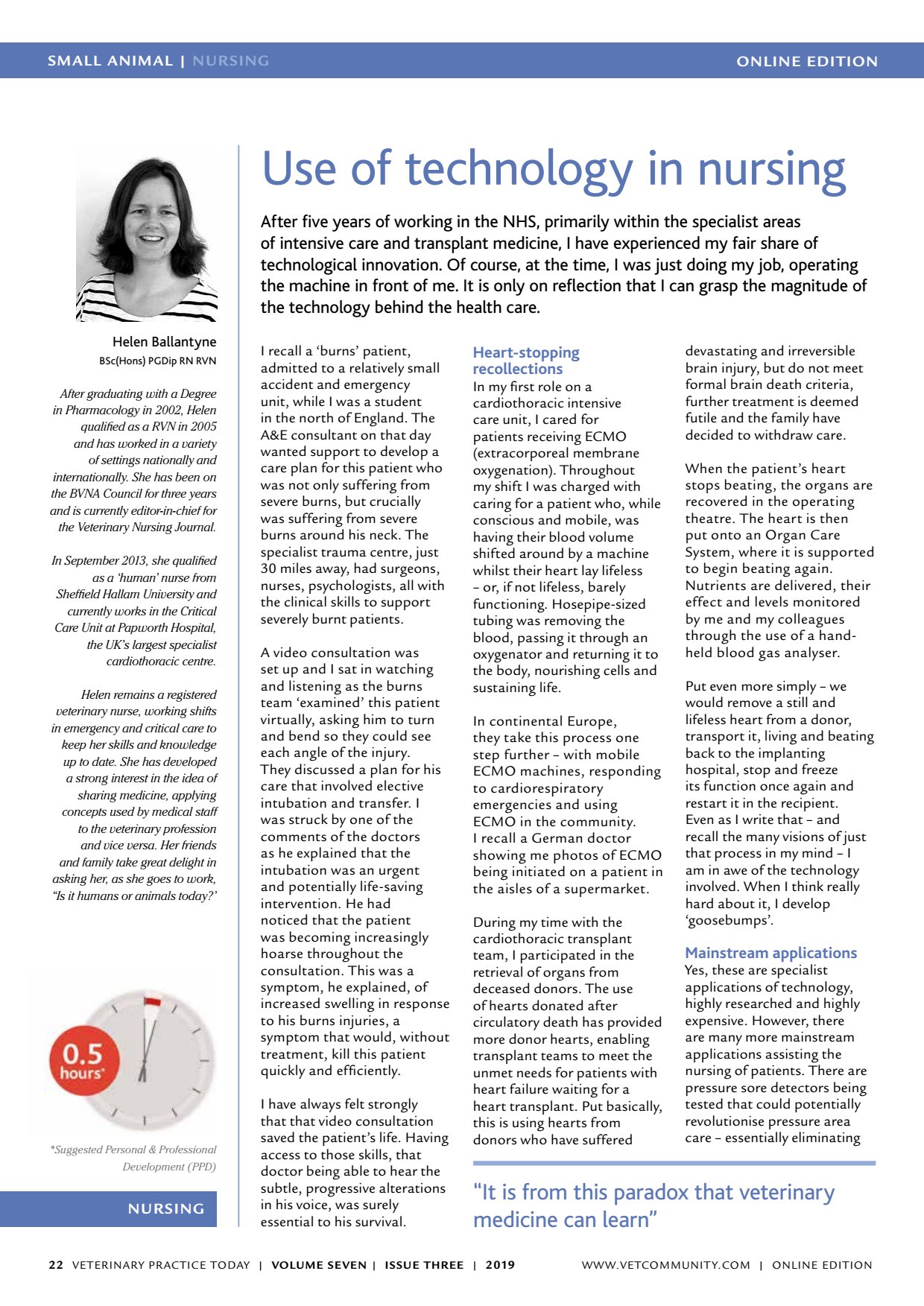technology nursing Heart-stopping
ONLINE EDITIONSMALL ANIMAL | NURSING VETERINARY PRACTICE TODAY | VOLUME SEVEN | ISSUE THREE | 2019 22 NURSING Suggested Personal & Professional Development (PPD) Use of technology in nursing After five years of working in the NHS, primarily within the specialist areas of intensive care and transplant medicine, I have experienced my fair share of technological innovation. Of course, at the time, I was just doing my job, operating the machine in front of me. It is only on reflection that I can grasp the magnitude of the technology behind the health care. I recall a burns patient, admitted to a relatively small accident and emergency unit, while I was a student in the north of England. The A&E consultant on that day wanted support to develop a care plan for this patient who was not only suffering from severe burns, but crucially was suffering from severe burns around his neck. The specialist trauma centre, just 30 miles away, had surgeons, nurses, psychologists, all with the clinical skills to support severely burnt patients. A video consultation was set up and I sat in watching and listening as the burns team examined this patient virtually, asking him to turn and bend so they could see each angle of the injury. They discussed a plan for his care that involved elective intubation and transfer. I was struck by one of the comments of the doctors as he explained that the intubation was an urgent and potentially life-saving intervention. He had noticed that the patient was becoming increasingly hoarse throughout the consultation. This was a symptom, he explained, of increased swelling in response to his burns injuries, a symptom that would, without treatment, kill this patient quickly and efficiently. I have always felt strongly that that video consultation saved the patients life. Having access to those skills, that doctor being able to hear the subtle, progressive alterations in his voice, was surely essential to his survival. Heart-stopping recollections In my first role on a cardiothoracic intensive care unit, I cared for patients receiving ECMO (extracorporeal membrane oxygenation). Throughout my shift I was charged with caring for a patient who, while conscious and mobile, was having their blood volume shifted around by a machine whilst their heart lay lifeless or, if not lifeless, barely functioning. Hosepipe-sized tubing was removing the blood, passing it through an oxygenator and returning it to the body, nourishing cells and sustaining life. In continental Europe, they take this process one step further with mobile ECMO machines, responding to cardiorespiratory emergencies and using ECMO in the community. I recall a German doctor showing me photos of ECMO being initiated on a patient in the aisles of a supermarket. During my time with the cardiothoracic transplant team, I participated in the retrieval of organs from deceased donors. The use of hearts donated after circulatory death has provided more donor hearts, enabling transplant teams to meet the unmet needs for patients with heart failure waiting for a heart transplant. Put basically, this is using hearts from donors who have suffered devastating and irreversible brain injury, but do not meet formal brain death criteria, further treatment is deemed futile and the family have decided to withdraw care. When the patients heart stops beating, the organs are recovered in the operating theatre. The heart is then put onto an Organ Care System, where it is supported to begin beating again. Nutrients are delivered, their effect and levels monitored by me and my colleagues through the use of a hand- held blood gas analyser. Put even more simply we would remove a still and lifeless heart from a donor, transport it, living and beating back to the implanting hospital, stop and freeze its function once again and restart it in the recipient. Even as I write that and recall the many visions of just that process in my mind I am in awe of the technology involved. When I think really hard about it, I develop goosebumps. Mainstream applications Yes, these are specialist applications of technology, highly researched and highly expensive. However, there are many more mainstream applications assisting the nursing of patients. There are pressure sore detectors being tested that could potentially revolutionise pressure area care essentially eliminating Helen Ballantyne BSc(Hons) PGDip RN RVN After graduating with a Degree in Pharmacology in 2002, Helen qualified as a RVN in 2005 and has worked in a variety of settings nationally and internationally. She has been on the BVNA Council for three years and is currently editor-in-chief for the Veterinary Nursing Journal. In September 2013, she qualified as a human nurse from Sheffield Hallam University and currently works in the Critical Care Unit at Papworth Hospital, the UKs largest specialist cardiothoracic centre. Helen remains a registered veterinary nurse, working shifts in emergency and critical care to keep her skills and knowledge up to date. She has developed a strong interest in the idea of sharing medicine, applying concepts used by medical staff to the veterinary profession and vice versa. Her friends and family take great delight in asking her, as she goes to work, Is it humans or animals today? It is from this paradox that veterinary medicine can learn WWW.VETCOMMUNIT Y.COM | ONLINE EDITION
